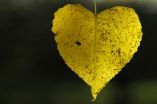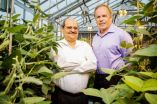(Press-News.org) The scientific world is one step closer to understanding how nature uses carbon-capture to tame poisons, thanks to a recent discovery of cyanoformate by researchers at Saint Mary's University (Halifax, Canada) and the University of Jyväskylä (Finland). This simple ion — which is formed when cyanide bonds to carbon dioxide — is a by-product of the fruit-ripening process that has evaded detection for decades.
Chemists have long understood the roles presence of cyanide (CN−) and carbon dioxide (CO2) in fruit ripening, but have always observed them independently. This is the first time scientists have isolated the elusive cyanoformate anion (NCCO2−) and characterized its structure using crystallography and computational chemistry.
The results of the two-year study led by Dr. Jason Clyburne, Saint Mary's University, and Dr. Heikki M. Tuononen, University of Jyväskylä, were released today in Science, the world's preeminent scientific journal.
Their findings demonstrate the profound effect the surrounding medium has on the stability of cyanoformate. This situational stability allows carbon dioxide to deactivate cyanide's toxic capabilities at the enzyme's active site where chemical reactions take place. Subsequently, the cyanoformate migrates to the cytoplasm of the cell where it breaks down, releasing the toxic cyanide at a location where it can be dealt with. While this explains how the formation of cyanide does not halt the fruit ripening process, the implications extend far beyond plants and a single enzyme. Recognizing the factors governing the stability of cyanoformate furthers our understanding of carbon-capture, a process used to trap and store carbon dioxide in the environment.
"Here we have a perfect example of nature taming a poison, and what better way to learn the chemistry of carbon-capture than from nature itself?" says Dr. Jason Clyburne, Canada Research Chair in Environmental Science and Materials, and professor of Environmental Science and Chemistry at Saint Mary's University.
"One of the biggest challenges in carbon capture is finding a material that not only captures CO2, but easily releases it," says Luke Murphy, a Masters of Science candidate at Saint Mary's who prepared the crystalline material for the study. "Cyanoformate does both and can be used as a model to develop a greener alternative."
This discovery highlights the importance of applied chemistry to other areas of science and indicates there is still more to be learned about the chemistry of carbon dioxide in cells.
"The fact that cyanoformate was undetected for so long begs the question: What other simple chemistry have we missed?" asks Dr. Heikki M. Tuononen, Academy of Finland research fellow, and senior lecturer at University of Jyväskylä, Finland.
INFORMATION:
More information, including a copy of the paper, can be found online at the Science press package at http://www.eurekalert.org/jrnls/sci. You will need your user ID and password to access this information.
Dr. Jason Clyburne is widely recognized as a leader in the study of green chemistry, particularly in the field of ionic liquids. In addition to holding a Canada Research Chair in Environmental Science and Materials at Saint Mary's University (Nova Scotia, Canada), Dr. Clyburne is an adjunct professor at Simon Fraser University and Section Co-Chair of the Inorganic Chemistry Evaluation Group with the Natural Sciences and Engineering Council of Canada.
Dr. Heikki M. Tuononen is an expert in computational chemistry, particularly in the field of main group systems. He currently holds a senior lectureship and an Academy of Finland research fellowship at the Department of Chemistry, University of Jyväskylä (Finland). Dr. Tuononen is also an adjunct professor in computational inorganic chemistry at University of Oulu.
Contributors: Based upon theoretical work conducted by Dr. Jani Moilanen at University of Jyväskylä (Finland), the cyanoformate anion was predicted to be a fragile, yet marginally stable synthetic target, which made it difficult to create in the lab. Luke Murphy, a Master of Applied Science candidate at Saint Mary's University, prepared the fragile crystalline material, and Saint Mary's research associate Dr. Katherine Robertson determined its structure. The atomic connectivity of the anion was successively confirmed with modern spectroscopic methods in collaboration with Scott Harroun from Dr. Christa Brosseau's laboratory at Saint Mary's and Dr. Ulrike Werner-Zwanziger from the solid-state Nuclear Magnetic Resonance Resource (NMR-3) at Dalhousie University (Halifax, Canada).
Support for this research was provided by Dr. Jason Clyburne's Discovery Grant from the Natural Sciences and Engineering Research Council of Canada and Dr. Heikki M. Tuononen's research grants from the Academy of Finland and the Technology Industries of Finland Centennial Foundation. Additional funding was provided by GreenCentre Canada, Encana Corporation (Deep Panuke Education & Training and Research & Development Fund), Springboard, and Dr. Jani Moilanen's postdoctoral scholarship from the Magnus Ehrnrooth Foundation.
Taming a poison: Saving plants from cyanide with carbon dioxide
2014-04-03
ELSE PRESS RELEASES FROM THIS DATE:
Hot mantle drives elevation, volcanism along mid-ocean ridges
2014-04-03
PROVIDENCE, R.I. [Brown University] — Scientists have shown that temperature differences deep within Earth's mantle control the elevation and volcanic activity along mid-ocean ridges, the colossal mountain ranges that line the ocean floor. The findings, published April 4 in the journal Science, shed new light on how temperature in the depths of the mantle influences the contours of the Earth's crust.
Mid-ocean ridges form at the boundaries between tectonic plates, circling the globe like seams on a baseball. As the plates move apart, magma from deep within the Earth rises ...
HIV vaccine research must consider various immune responses
2014-04-03
WHAT:Last year, the National Institute of Allergy and Infectious Diseases (NIAID), part of the National Institutes of Health, held a scientific meeting to examine why certain investigational HIV vaccines may have increased susceptibility to HIV infection. In a new perspectives article appearing in the journal Science, HIV research leaders from NIAID (Anthony S. Fauci, M.D., and Carl W. Dieffenbach, Ph.D.) and its grantees at Emory University (Eric Hunter, Ph.D.) and the University of California, San Francisco (Susan Buchbinder, M.D.), summarize the findings and considerations ...
Moving the fence posts
2014-04-03
The use of fenced areas to protect threatened species in the wild should be a last resort, argue scientists from the Zoological Society of London (ZSL) and the Wildlife Conservation Society (WCS).
In an article published in the journal Science, the authors state that there is a need to review the use of fencing as the conservation community develops a clearer understanding of the ecological changes caused when an area is fenced.
Fencing can have a disruptive impact on predator-prey dynamics, with species such as the African wild dog learning to chase prey into fences. ...
Researchers design trees that make it easier to produce paper
2014-04-03
Researchers have genetically engineered trees that will be easier to break down to produce paper and biofuel, a breakthrough that will mean using fewer chemicals, less energy and creating fewer environmental pollutants.
"One of the largest impediments for the pulp and paper industry as well as the emerging biofuel industry is a polymer found in wood known as lignin," says Shawn Mansfield, a professor of Wood Science at the University of British Columbia.
Lignin makes up a substantial portion of the cell wall of most plants and is a processing impediment for pulp, ...
Cassini reports sub-surface ocean on Enceladus
2014-04-03
Enceladus—one of Saturn's smaller satellites—has joined the ranks of Titan and Europa as a moon that appears to have liquid water splashing around inside of it, researchers say. New gravity data from the Cassini spacecraft, which has been exploring the planet's moons for 10 years, reveal that Enceladus harbors an ocean of water beneath 18 to 24 miles (30 to 40 kilometers) of ice at its surface.
A team of Italian and American scientists led by Luciano Iess at Sapienza Università di Roma in Rome, Italy investigated the moon's gravity field and the notable asymmetry it ...
Gravity measurements confirm subsurface ocean on Enceladus
2014-04-03
In 2005, NASA's Cassini spacecraft sent pictures back to Earth depicting an icy Saturnian moon spewing water vapor and ice from fractures, known as "tiger stripes," in its frozen surface. It was big news that tiny Enceladus—a mere 500 kilometers in diameter—was such an active place. Since then, scientists have hypothesized that a large reservoir of water lies beneath that icy surface, possibly fueling the plumes. Now, using gravity measurements collected by Cassini, scientists have confirmed that Enceladus does in fact harbor a large subsurface ocean near its south pole, ...
'Unzipping' poplars' biofuel potential
2014-04-03
EAST LANSING, Mich. — What began 20 years ago as an innovation to improve paper industry processes and dairy forage digestibility may now open the door to a much more energy- and cost-efficient way to convert biomass into fuel.
The research, which appears in the current issue of Science, focuses on enhancing poplar trees so they can break down easier and thus improving their viability as a biofuel. The long-term efforts and teamwork involved to find this solution can be described as a rare, top-down approach to engineering plants for digestibility, said Curtis Wilkerson, ...
Study shows more than half of high-risk alcohol users report improvement after surgery
2014-04-03
BOSTON – Much has been reported about the potential for increased risk of alcohol misuse after weight loss surgery (WLS), with most theories pointing to lower alcohol tolerance and a longer time to return to a sober state after surgery, but a new study from Beth Israel Deaconess Medical Center suggests that upwards of half of high-risk drinkers are actually less likely to report high-risk drinking behavior after weight loss surgery.
The results appear in the journal, Surgery for Obesity and Related Diseases.
"This is the first study to show that high-risk drinking ...
Aging workforce requires new strategies for employee retention, MU researcher says
2014-04-03
COLUMBIA, Mo. – As more baby boomers reach retirement age, state governments face the likelihood of higher workforce turnover. For example, in the state of Missouri, more than 25 percent of all active state employees will be eligible to retire by 2016. Such large numbers of retirees threaten the continuity, membership and institutional histories of the state government workforce, according to Angela Curl, assistant professor in the University of Missouri School of Social Work. In a case study of the state of Missouri's Deferred Retirement Option Provision (BackDROP), Curl ...
Scientists say new computer model amounts to a lot more than a hill of beans
2014-04-03
CHAMPAIGN, Ill. — Crops that produce more while using less water seem like a dream for a world with a burgeoning population and already strained food and water resources. This dream is coming closer to reality for University of Illinois at Urbana-Champaign researchers who have developed a new computer model that can help plant scientists breed better soybean crops.
Under current climate conditions, the model predicts a design for a soybean crop with 8.5 percent more productivity, but using 13 percent less water, and reflecting 34 percent more radiation back into space, ...


